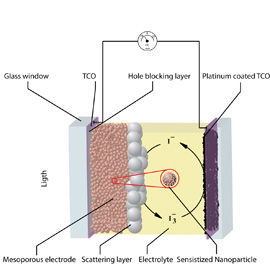A team of researchers from The University of Pennsylvania and Drexel University is exploring ways to develop more-efficient, long-lasting and low-cost photoelectric cells using nanotechnology and mathematical modeling.
 Engineers from Drexel and Penn are looking at two areas where dye-sensitized solar panels could be made more efficient and testing their theories via mathematical modeling software.
Engineers from Drexel and Penn are looking at two areas where dye-sensitized solar panels could be made more efficient and testing their theories via mathematical modeling software.
The National Science Foundation awarded a three-year grant to the team for this work. The team is studying dye-sensitized solar panels, wherein a photosensitive dye captures radiation, which is then transformed into electricity. The objective of the team is to optimize the electron transfer process within the solar panels so that they can efficiently transform radiation into electricity.
Current conversion efficiency of dye-sensitized solar panels is around 11-12%. The team is trying to fabricate dye-sensitized solar panels that have efficiency comparable to that of silicon panels, which now have double the conversion efficiency of dye-sensitized counterparts. Although dye-sensitized solar panels have several benefits over silicon counterparts, their poor conversion efficiency is an obstacle to their widespread adoption.
The team attempted to align the erratic motion of photogenerated or radiation-excited electrons into a more systematic flow through the inside of solar cells by improving the material in its electrolyte substrate. The researchers are trying to control this rapid transition of photogenerated electrons by putting in carbon nanotubes to function as corrals for the electrons to escape.
According to Dr. Daeyeon Lee, one of the researchers, besides providing uninterrupted pathways for electrons, carbon nanotubes avoid the loss of photogenerated electrons during transition from the solar cell into the external circuit. The team anticipates an increase in the solar cell’s overall charge collection efficiency with the insertion of the nanotubes.
The second part of the work focused on using a more-efficient polymer substance in place of a liquid electrolyte that isolates the electrodes within the solar cell. According to the research team, the negatively charged species can transit more efficiently in polymer substance when compared to the liquid electrolyte, which also causes leakage issues as it is difficult to seal the liquid. The solid polymer also reduces the major conversion losses by preventing electron loss, explained one of the researchers, Dr. Kenneth Lau.
Lau's team also developed a technique to put the polymer inside the sponge-like electrode, an issue that enforces the utilization of a liquid electrolyte in present solar cells. The researchers will use a computational material design program devised by Dr. Masoud Soroush, a member of the team, to find out the most effective combination of polymer composition and nanotube placement to get the design specifications that will enhance the operation of the dye-sensitized solar cell.